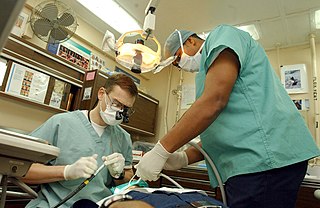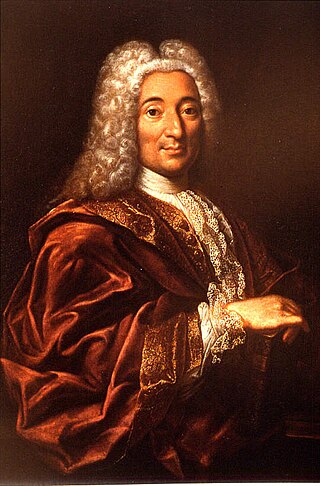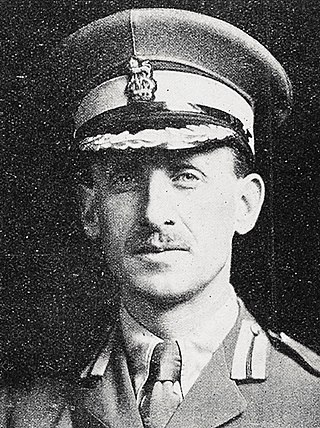
Sir Auguste Charles Valadier (26 November 1873–31 August 1931) was a Franco-American dental surgeon who pioneered new techniques and equipment for treating maxillofacial injuries of soldiers during World War I. [1]

Sir Auguste Charles Valadier (26 November 1873–31 August 1931) was a Franco-American dental surgeon who pioneered new techniques and equipment for treating maxillofacial injuries of soldiers during World War I. [1]
Valadier was born in Paris, France in 1873, the son of Marie-Antoinette and Charles Jean-Baptiste Valadier, a pharmacist. As a boy he and his two younger brothers were taken to live in the United States by his parents. [2] He entered the Philadelphia Dental College as a student in about 1898, and qualified as Doctor of Dental Surgery (DDS) in 1901. He next took the State examinations which allowed him to practice in Pennsylvania and New York, practicing in the latter for five years. [3]
By 1910 Valadier's mother was widowed and wealthy and living in Paris, and on the death of her other son she persuaded Valadier to join her there. As he had no French dental qualifications, Valadier studied at l'Ecole Odontotechnique de Paris from November 1910 to June 1911, and received the certificate of Chirugien Dentiste from the Faculty of Medicine of the University of Paris in July 1912, following which he was permitted to practice in France. In July 1913 he married Alice Wright, the granddaughter of Robert Clinton Wright, a former United States Minister in Brazil. [3]
On the outbreak of World War I in 1914 Valadier joined the British Red Cross Society (BRCS) in Paris who sent him to Abbeville. The History of the Great War (1922) records: "Dental surgeons commenced to arrive in France in early November and were allocated to clearing hospitals and to the bases. An eminent dentist, M. Valadier, a citizen of the United States, who had been sent from Paris to Abbeville by the BRCS, was also accepted for duty with the British troops on 29 October." [4] Valadier seems to have been the first dental surgeon to have provided dental treatment for the British troops in France. The dental surgeons sent over by the War Office were given temporary commissions while attached to the Royal Army Medical Corps, and Valadier was gazetted as an honorary Lieutenant, and in 1916 was promoted to Major. [3]
By early 1915 Valadier had set up a 50-bed unit attached to the 83rd (Dublin) General Hospital at Wimereux for the treatment of facial injuries. Much of this work was done at his own expense, while his own dental technicians in his dental laboratory in Paris fashioned the dental appliances necessary for the treatment of fractures to the jaw. It was decided that in the operating theatre Valadier would require the assistance of a trained surgeon, and so Harold Gillies joined his team. It is not known how long Gillies stayed with Valadier, but it was certainly long enough to inspire Gillies a desire to learn more about this new medical treatment, [3]
On 17 May 1915 The Daily Sketch reported on a case of reconstructive surgery performed by Valadier:
WAR'S MOST WONDERFUL SURGICAL FEATWounded Highlander Who Was Given A New MouthSurely the most wonderful surgical feat of the war so far must be that achieved by Lieut. Valadier, R.A.M.C., for a Highlander.
The story was told the Daily Sketch yesterday at the fascinating exhibition of fracture apparatus now being held on the premises of the Royal Society of Medicine, London.
At Neuve Chapelle the Highlander was hit, and the simplest way to describe what happened to him is to say that he lost his mouth.
He was looking up when a piece of shell struck him in the left cheek. It passed through his top lip, shattered the upper jaw, fell upon the lower jaw, and smashed that. Then it glanced off and buried itself into his right shoulder.
SKILFUL ARMY SURGEONTaken to hospital, the Highlander had the good fortune to fall into the hands of Lieutenant Valadier, who is a Frenchman by birth. He has studied in the States, and is now attached to the Royal Army Medical Corps.
The patient's mouth was just a shapeless mess. Lieutenant Valadier was able to provide an artificial mouth-floor, and then, by using a special type of splints, to draw the sides into position again. The jaws were in some marvellous manner reset, and the man was given new teeth.
Now he can eat and speak as well as ever, and has only one light scar to show that anything has ever happened to him. [5]

Dentistry, also known as dental medicine and oral medicine, is the branch of medicine focused on the teeth, gums, and mouth. It consists of the study, diagnosis, prevention, management, and treatment of diseases, disorders, and conditions of the mouth, most commonly focused on dentition as well as the oral mucosa. Dentistry may also encompass other aspects of the craniofacial complex including the temporomandibular joint. The practitioner is called a dentist.

Plastic surgery is a surgical specialty involving the restoration, reconstruction, or alteration of the human body. It can be divided into two main categories: reconstructive surgery and cosmetic surgery. Reconstructive surgery covers a wide range of specialties, including craniofacial surgery, hand surgery, microsurgery, and the treatment of burns. This category of surgery focuses on restoring a body part or improving its function. In contrast, cosmetic surgery focuses solely on improving the physical appearance of the body. A comprehensive definition of plastic surgery has never been established, because it has no distinct anatomical object and thus overlaps with practically all other surgical specialties. An essential feature of plastic surgery is that it involves the treatment of conditions that require or may require tissue relocation skills.

Sir Harold Delf Gillies was a New Zealand otolaryngologist and father of modern plastic surgery for the techniques he devised to repair the faces of soldiers coming back from the trenches.

A dentist, also known as a dental surgeon, is a health care professional who specializes in dentistry, the branch of medicine focused on the teeth, gums, and mouth. The dentist's supporting team aids in providing oral health services. The dental team includes dental assistants, dental hygienists, dental technicians, and sometimes dental therapists.
Oral and maxillofacial surgery is a surgical specialty focusing on reconstructive surgery of the face, facial trauma surgery, the mouth, head and neck, and jaws, as well as facial plastic surgery including cleft lip and cleft palate surgery.
Prosthodontics, also known as dental prosthetics or prosthetic dentistry, is the area of dentistry that focuses on dental prostheses. It is one of 12 dental specialties recognized by the American Dental Association (ADA), Royal College of Surgeons of England, Royal College of Surgeons of Edinburgh, Royal College of Surgeons of Ireland, Royal College of Surgeons of Glasgow, Royal College of Dentists of Canada, and Royal Australasian College of Dental Surgeons. The ADA defines it as "the dental specialty pertaining to the diagnosis, treatment planning, rehabilitation and maintenance of the oral function, comfort, appearance and health of patients with clinical conditions associated with missing or deficient teeth or oral and maxillofacial tissues using biocompatible substitutes."

Orthognathic surgery, also known as corrective jaw surgery or simply jaw surgery, is surgery designed to correct conditions of the jaw and lower face related to structure, growth, airway issues including sleep apnea, TMJ disorders, malocclusion problems primarily arising from skeletal disharmonies, and other orthodontic dental bite problems that cannot be treated easily with braces, as well as the broad range of facial imbalances, disharmonies, asymmetries, and malproportions where correction may be considered to improve facial aesthetics and self-esteem.

Pierre Fauchard was a French physician, credited as being the "father of modern dentistry". He is widely known for writing the first complete scientific description of dentistry, Le Chirurgien Dentiste, published in 1728. The book described basic oral anatomy and function, signs and symptoms of oral pathology, operative methods for removing decay and restoring teeth, periodontal disease (pyorrhea), orthodontics, replacement of missing teeth, and tooth transplantation.
Simon Hullihen MD, DDS was a dental surgeon born in Point Township, Pennsylvania. He completed his medical degree and then was inspired to seek a career in oral and maxillofacial surgery. Regarded as the first oral surgeon in the United States, he helped to develop many modern techniques of maxillofacial surgery and contributed to the establishment of oral and maxillofacial surgery as a surgical specialty.
Pierre Robin was a French stomatologist from Paris. He was professor at the French School of Stomatology, and from 1914, he was editor-in-chief of the Revue de Stomatologie.
In the United States and Canada, there are twelve recognized dental specialties in which some dentists choose to train and practice, in addition to or instead of general dentistry. In the United Kingdom and Australia, there are thirteen.

Hippolyte Morestin was a French surgeon, and associate professor of anatomy at the University of Paris. He was one of the founders of cosmetic surgery. He was dubbed "The Father of the Mouths" after his breakthroughs in oral and maxillofacial surgery.
The British Association of Oral and Maxillofacial Surgeons is the British medical association for oral and maxillofacial surgeons - dual qualified surgeons, qualified in both medicine and dentistry.

Henry Percy Pickerill (1879–1956) was a British-born New Zealand dental surgeon and researcher, university administrator and plastic surgeon. Pickerill made major contributions to several fields of dentistry and plastic surgery both in New Zealand and overseas.
Impacted wisdom teeth is a condition where the third molars are prevented from erupting into the mouth. This can be caused by a physical barrier, such as other teeth, or when the tooth is angled away from a vertical position. Completely unerupted wisdom teeth usually result in no symptoms, although they can sometimes develop cysts or neoplasms. Partially erupted wisdom teeth or wisdom teeth that are not erupted but are exposed to oral bacteria through deep periodontal pocket, can develop cavities or pericoronitis. Removal of impacted wisdom teeth is advised for the future prevention of or in the current presence of certain pathologies, such as caries, periodontal disease or cysts. Prophylactic (preventative) extraction of wisdom teeth is preferred to be done at a younger age to take advantage of incomplete root development, which is associated with an easier surgical procedure and less probability of complications.
Robert H. Ivy (1881–1974) was an American oral and plastic surgeon who is known to develop the team approach or multidisciplinary treatment involving care of children with Cleft lip and cleft palate. He is one of the early pioneers in the specialty of plastic surgery due to his surgical experience in World War I. During an intermaxillary fixation technique, Ivy Loop is named after Dr. Ivy.

Georg Axhausen was a German oral and maxillofacial surgeon.
Hugo Obwegeser was an Austrian Oral and Maxillo-Facial Surgeon and Plastic Surgeon who is known as the father of the modern orthognathic surgery. In his publication of 1970, he was the first surgeon to describe the simultaneous procedure which involved surgeries of both Maxilla and Mandible involving Le Fort I and Bilateral Sagittal Split Osteotomy technique.
Norman Rowe, was a British oral and maxillofacial surgeon who was a defining influence in the development of oral and maxillofacial surgery in the United Kingdom.

Sir William Kelsey Fry was a British dental surgeon who, with Harold Gillies, was an important figure in the development of oral and maxillofacial surgery during World War I.